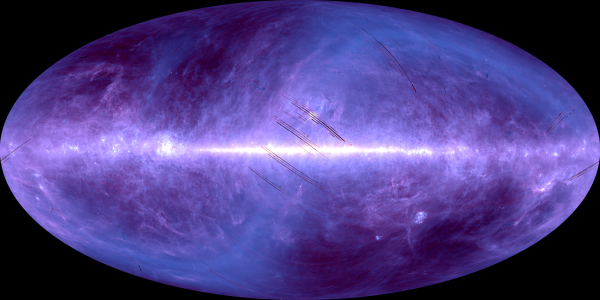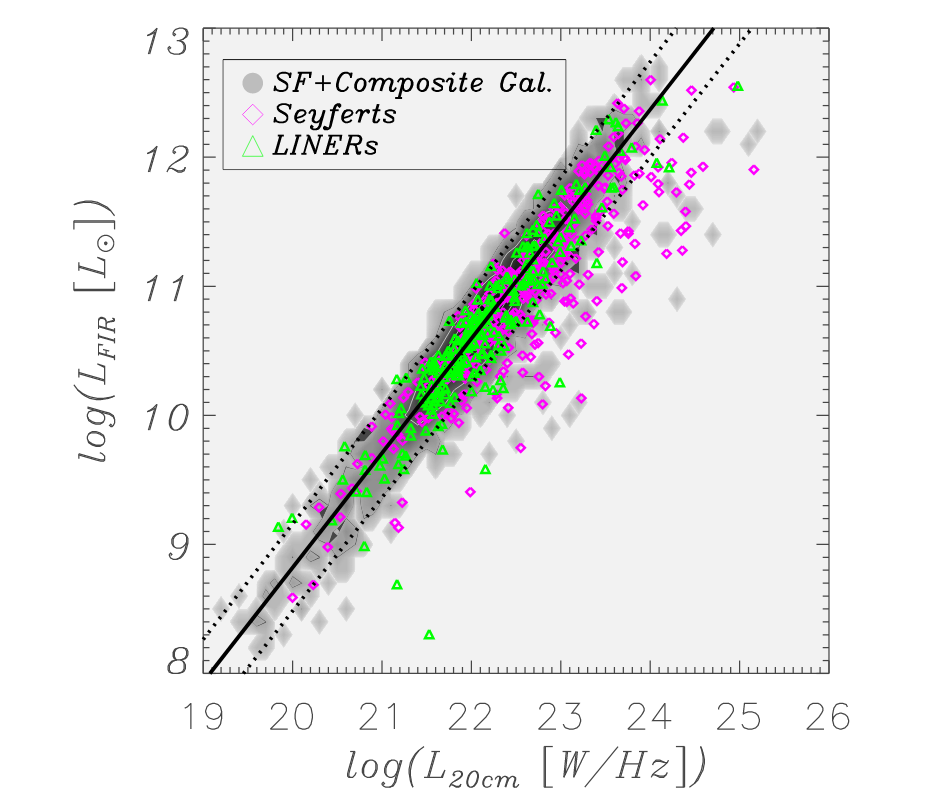Astronomy Object of the Month: 2019, June
< previous Archive next >
Dusty galaxies from the AKARI All Sky Survey
A tight far infrared-radio emission correlation for galaxies is
a well known phenomenon, which appears to extend from the local Universe up to high redshifts and for a wide range of galaxy
masses and types. It is attributed to recent star formation processes which produce both far infrared (related to the star-formation
process in galaxies through dust particles produced in their life-cycles, which absorb the ultraviolet radiation emitted by young,
massive and hot stars and re-emit it at longer wavelengths) and synchrotron radiation (massive stars explode as supernovae and the
resulting cosmic rays are accelerated in the magnetic field of the galaxy, producing
synchrotron emission.)

Illustration 1: AKARI all-sky image: 90 and 140 micrometres. Credit: JAXA

Illustration 2: Total infrared luminosity (LFIR) plotted against radio luminosity at 1.4 GHz. The solid line represents the best least-square fit to the data, and the dashed lines mark the 95% confidence interval of the linear regression. Green triangles represent LINERs, pink diamonds represent Seyfert galaxies, and shaded contours are star-forming and composite galaxies. Credit: the Authors.
Location of the far infrared radiation peak varies depending on the intensity of the interstellar radiation field and is a good indicator of dust heating in the interstellar medium. Far infrared radiation is observed both in star-forming galaxies and in a large fraction of sources with an active galactic nucleus - AGN. Similar trend is also visible for the mid-IR - radio correlation. Past observations indicated that AGNs display a larger scatter in the far infrared emission than star-forming galaxies. This fact may be useful in selecting obscured AGNs with a radio-loud nature, missed by deep X-ray observations.
However, more recent studies show that optically selected AGNs often follow the correlation as tightly as star forming galaxies. Most galaxies containing AGNs have their far infrared-to-radio flux ratios indistinguishable from those of the star forming ones, with the exception of Seyfert galaxies.
New study of international team led by astronomers from National Centre for Nuclear Research and Jagiellonian University used the newest measurements from the AKARI Far-Infrared All Sky Survey. The AKARI data have been cross-correlated with the NVSS radio catalogue at 1.4 GHz. AKARI mission provides better sensitivities than the preceding all-sky infrared mission of the IRAS satellite and has much larger sky coverage (exceeding 98% of the sky) than targeted observations provided by Spitzer Telescope or Herschel Space Observatory.
The team investigated the correlation of radio and far infrared emission from star-forming galaxies, composite galaxies, Seyfert galaxies and so called LINERs (galactic nuclei defined by its spectral line emission, with the spectra typically including line emission from weakly ionized or neutral atoms). They identified AGNs based on the use of the SDSS DR8 data release as the spectroscopic resource.
It turns out that while the composite galaxy population is statistically indistinguishable from the population of star-forming galaxies based on the far infrared emission only, Seyfert galaxies have a different distribution of the parameter (FIR/radio ratio) quantifying this correlation. The difference between Seyferts and star-forming galaxies is statistically significant for sources with high radio and infrared luminosities. Furthermore, Seyfert galaxies display bigger scatter in the far-infrared waves than LINER galaxies. These results are in agreement with the previous works reporting that the star-forming galaxies, as well as galaxies hosting AGNs, can be separated based on their position on the far-infrared correlation diagram - but for the most radio-luminous sources only.
Original publication: Radio-Infrared Correlation for Local Dusty Galaxies and Dusty AGNs from the AKARI All Sky Survey; A. Solarz, A. Pollo, M. Bilicki, A. Pępiak, T. T. Takeuchi, P. Piątek, Publ. Astron. Soc. Japan (2018).
The research was conducted at the Department of Stellar and Extragalactic Astronomy of the Jagiellonian University’s Astronomical Observatory.
This research was supported by the National Science Centre grants UMO-2015/16/S/ST9/00438 and UMO-2014/13/N/ST9/00078 and Grants-in-Aid for Scientific Research JSPS/MEXT KAKENHI No. 17H01110.
|
Agata Pępiak Astronomical Observatory Jagiellonian University A.Pepiak [at] uj.edu.pl |
Agnieszka Pollo Astronomical Observatory Jagiellonian University A.Pollo [at] uj.edu.pl |


